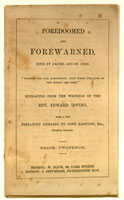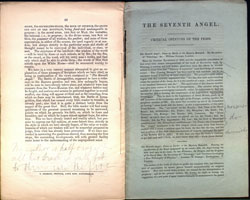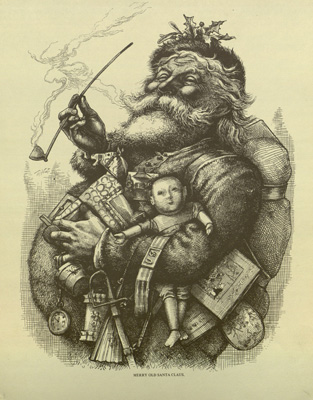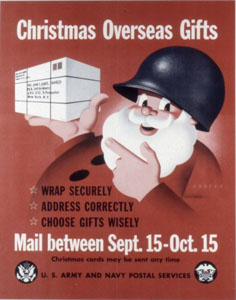Still waiting for the world to end? Perhaps you need a different apocalyptic prophecy. Don't worry, Special Collections has plenty! They may not be Mayan, but here's a small sampling of various ways the world could have ended over the past 350 years.
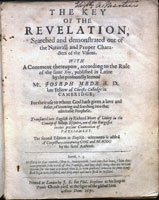 Joseph Mede (1586–1638) was a fellow of Christ's College, Cambridge, and a recognized authority on the Bible, Hebrew language, and ancient Egypt. In his Clavis apocalypseos (Key to the Revelation), Mede claimed that the book of Revelation should be interpreted literally as a prophecy of world history. An ancient Near Eastern text on dream interpretation, he argued, provides the key to interpreting the book's symbolism. Mede identified Rome as the Antichrist and the source of the apostasy supposed to come with the end times. He thought the biblical Apocalypse would occur sometime prior to 1716, and suggested 1654 as a probable date. Mede's work had broad influence, and its translation into English after his death renewed interest in the apocalypse among English scholars and religious leaders.
Joseph Mede (1586–1638) was a fellow of Christ's College, Cambridge, and a recognized authority on the Bible, Hebrew language, and ancient Egypt. In his Clavis apocalypseos (Key to the Revelation), Mede claimed that the book of Revelation should be interpreted literally as a prophecy of world history. An ancient Near Eastern text on dream interpretation, he argued, provides the key to interpreting the book's symbolism. Mede identified Rome as the Antichrist and the source of the apostasy supposed to come with the end times. He thought the biblical Apocalypse would occur sometime prior to 1716, and suggested 1654 as a probable date. Mede's work had broad influence, and its translation into English after his death renewed interest in the apocalypse among English scholars and religious leaders.
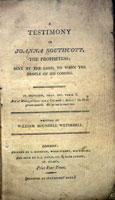 The daughter of a farmer, Joanna Southcott (1750–1814) proclaimed herself a prophet and visionary in her early 40s. She saw herself as a champion of the poor, and she gained credibility and a large following when some of her public predictions came true. In 1814, at the age of 64, Southcott believed herself to be pregnant with the second incarnation of God. The child, named Shiloh, was supposed to usher in the Millennium, the thousand years of peace that some Christians believe will occur before the Last Judgement. Rather than giving birth, Southcott died on December 27 of that year. Her followers preserved her legacy, including a box of sealed prophecies, into the twentieth century.
The daughter of a farmer, Joanna Southcott (1750–1814) proclaimed herself a prophet and visionary in her early 40s. She saw herself as a champion of the poor, and she gained credibility and a large following when some of her public predictions came true. In 1814, at the age of 64, Southcott believed herself to be pregnant with the second incarnation of God. The child, named Shiloh, was supposed to usher in the Millennium, the thousand years of peace that some Christians believe will occur before the Last Judgement. Rather than giving birth, Southcott died on December 27 of that year. Her followers preserved her legacy, including a box of sealed prophecies, into the twentieth century.
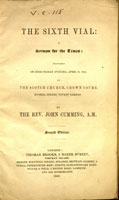 John Cumming (1807-1881) was a Presbyterian preacher whose career was initially built on popularizing established forms of worship. By the 1840s, his congregation numbered over 4,000, and he was patronized by members of the peerage and social elite. At the height of his popularity, Cumming turned increasingly to the study of biblical prophecy. His interpretations of the books of Genesis and Daniel led him to believe that the second coming would occur in 1867. Even after that year passed, Cumming continued to publish pamphlets with apocalyptic and prophetic themes, despite the decline of his congregation and popularity.
John Cumming (1807-1881) was a Presbyterian preacher whose career was initially built on popularizing established forms of worship. By the 1840s, his congregation numbered over 4,000, and he was patronized by members of the peerage and social elite. At the height of his popularity, Cumming turned increasingly to the study of biblical prophecy. His interpretations of the books of Genesis and Daniel led him to believe that the second coming would occur in 1867. Even after that year passed, Cumming continued to publish pamphlets with apocalyptic and prophetic themes, despite the decline of his congregation and popularity.
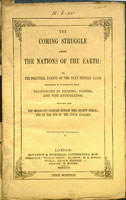 Very little is known of David Pae (1828-1884), but he seems to have been a contemporary of Cumming. His pamphlet The Coming Struggle among the Nations of the Earth laid out a detailed sequence of world events Pae claimed would take place over a fifteen-year span, starting in 1853, and ending with Britain dominant over most of the world. This hegemony, Pae argued, would set the stage for the end times, in which those of Anglo-Saxon descent would feature as God's chosen people. Pae published at least two follow-ups to The Coming Struggle to counter objections and answer questions about his very Anglo-centric prophecies.
Very little is known of David Pae (1828-1884), but he seems to have been a contemporary of Cumming. His pamphlet The Coming Struggle among the Nations of the Earth laid out a detailed sequence of world events Pae claimed would take place over a fifteen-year span, starting in 1853, and ending with Britain dominant over most of the world. This hegemony, Pae argued, would set the stage for the end times, in which those of Anglo-Saxon descent would feature as God's chosen people. Pae published at least two follow-ups to The Coming Struggle to counter objections and answer questions about his very Anglo-centric prophecies.
Special Collections has dozens of other works on eschatology. Some attempt to interpret contemporary events as signs of the end; others are works of prophecy. Many are serious treatises written by theological scholars, while others are perhaps better characterized by this manuscript note, from a nineteenth-century reader: "The author is half crazy & all his trash is only fit to throw into the fire."
But don't take that reader's word for it; you be the judge! Search the MERLIN catalog under the keywords Eschatology, Apocalypse, and End of the World, and find your own favorite work of impending doom.
